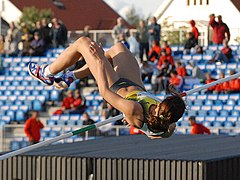High jumper
|
Athletics High jump |
|
|---|---|

Yelena Slesarenko using the Fosbury Flop technique during the 2004 Summer Olympics in Athens, Greece.
|
|
| Men's records | |
| World | Javier Sotomayor 2.45 m (8 ft 0 1⁄4 in) (1993) |
| Olympic | Charles Austin 2.39 m (7 ft 10 in) (1996) |
| Women's records | |
| World | Stefka Kostadinova 2.09 m (6 ft 10 1⁄4 in) (1987) |
| Olympic | Yelena Slesarenko 2.06 m (6 ft 9 in) (2004) |
The high jump is a track and field event in which competitors must jump unaided over a horizontal bar placed at measured heights without dislodging it. In its modern most practised format, a bar is placed between two standards with a crash mat for landing. In the modern era, athletes run towards the bar and use the Fosbury Flop method of jumping, leaping head first with their back to the bar. Performed since ancient times, competitors have introduced increasingly more effective techniques to arrive at the current form.
The discipline is, alongside the pole vault, one of two vertical clearance events to feature on the Olympic athletics programme. It is contested at the World Championships in Athletics and IAAF World Indoor Championships, and is a common occurrence at track and field meetings. The high jump was among the first events deemed acceptable for women, having been held at the 1928 Olympic Games.
Javier Sotomayor (Cuba) is the current men's record holder with a jump of 2.45 m (8 ft 0 1⁄4 in) set in 1993 – the longest standing record in the history of the men's high jump. Stefka Kostadinova (Bulgaria) has held the women's world record at 2.09 m (6 ft 10 1⁄4 in) since 1987, also the longest-held record in the event.
The rules for the high jump are set internationally by the International Association of Athletics Federations (IAAF). Jumpers must take off on one foot. A jump is considered a failure if the bar is dislodged by the action of the jumper whilst jumping or the jumper touches the ground or breaks the plane of the near edge of the bar before clearance. The technique one uses for the jump must be almost flawless in order to have a chance of clearing a high bar.
Competitors may begin jumping at any height announced by the chief judge, or may pass, at their own discretion. Three consecutive missed jumps, at any height or combination of heights, will eliminate the jumper from competition.
...
Wikipedia
